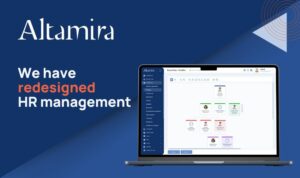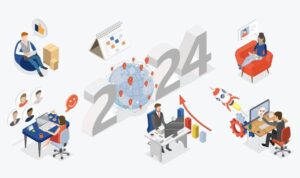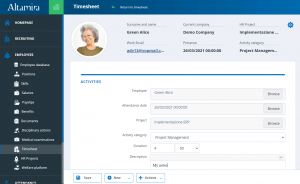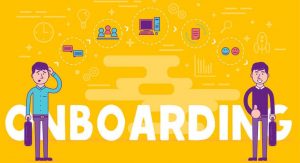Training will be one of the main keys to a strong economic recovery after the crisis triggered by the pandemic.
Reskilling and upskilling, i.e. the updating and development of the staff’s skills to be up to the constant changes in the world of work, will be essential elements allowing companies to take advantage of a restart that will be based on innovation and a green economy.
This is a difficult test of maturity for businesses, which are not always inclined to invest in this area.
To pass this test, what is needed is the right mindset, serious planning work and the support of technology.
Here are 14 initiatives that will help you build an efficient and inclusive training plan.
1. Identify the goals and objectives of the training plan
To properly design a company training plan, you must be clear about its purpose.
Common objectives include:
- to develop internal competencies in order to have workers who are more skilled and up to speed with changes (in technology, processes, best practices, etc.)
- to improve employer branding and attract top talent
- to stimulate engagement and reduce the voluntary turnover rate
- to ensure compliance with workplace safety regulations and reduce the risk of accidents
Once the main objectives and their levels of priority have been identified, it is advisable to associate them with concrete and measurable goals according to the SMART methodology.
For example, the training plan might need to achieve the following:
- help reduce turnover to 10% over two years
- increase the number of applications by 5%
- get 95% of employees up to speed on safety training
One must not forget that the strategic business objectives should work in concert with, and not stifle, the professional development objectives of the individual employees.
2. Analyze training needs
This phase is closely intertwined with the previous one.
To design a training plan, in addition to setting priorities, you need to know your starting point and where you want to get to.
It is therefore necessary to carry out an analysis (mapping) of internal competencies and an identification of existing gaps, i.e. the gaps in the skills of employees that don’t allow them to carry out their duties adequately and/or continue on their internal career path.
This analysis should identify priorities and urgencies and guide the creation of a training plan for the short, medium, and long term.
This will allow you to make the most of all the tools available to the company, such as externally funded training, to get the best return on investment.
3. Get support from technology
Training is one of the HR processes for which many companies still tend to settle for using spreadsheets as support, and not investing in dedicated software.
The result is a training plan that is opaque and non-interactive, requires a huge amount of data entry, makes KPI management very difficult, and must be recreated almost in its entirety year after year.
It’s much better to rely on a Learning Management System that gives self-service access to employees, so they are actively involved in the training process.
Other benefits of these systems include:
- tracking of the history of courses taken, grades received, certifications obtained
- recording course attendance
- keeping track of the skills developed
- delivering educational material
- sending notifications and reminders
- the possibility of delivering courses online
4. Leverage microlearning and mobile learning
In the modern world of work, it is becoming more and more difficult for managers and employees to carve out several consecutive hours to devote to training, without the risk of being interrupted by emergencies and important tasks.
For this reason, companies must use recent innovations such as microlearning and mobile learning, offering content that is broken up into bite-sized training chunks, which can be “consumed” in very short sessions, including through smartphones.
This doesn’t mean offering more superficial courses, but rather breaking up the same content into several consecutive sessions, organized like playlists.
5. Know when you should outsource
Producing the training content in-house and having your employees deliver it is not a bad choice in itself, but it should only be adopted in the right circumstances.
For example, it’s a good idea when specific skills and technical knowledge need to be conveyed about internal processes, which are difficult to find outside the company.
Or, again, when it comes to conveying values that have to do with the company’s mission and climate.
However, when it’s time to train employees on soft or less specialized skills, it’s more efficient to turn to external trainers, who have standard training materials and staff who specialize in the field.
In this way, you also avoid taking valuable time away from your colleagues—who, moreover, are not educators by trade and might not be skilled in teaching.
6. Don’t just focus on managers and team leaders
Some companies choose to invest only in the training of their senior human resources, thinking they will get the best return on investment.
While it is critical to develop the soft skills of those in managerial and team management roles, such a choice rarely pays off.
The rest of the workforce plays an equally vital role in the success of the firm. If you deprive them of training opportunities, it will be impossible to bring out the potential in everyone, and also develop the internal resources and get them on career paths.
As a result, the company will be forced to seek out and hire new people externally, a more costly route than developing its internal resources.
7. Track KPIs
The projects that are able to prove their effectiveness with numbers are the ones most likely to take root in the company and gain the support they need to continue over time.
Being able to calculate a complete ROI for corporate training is the dream of every HR department, but the enormous number of variables involved makes this very difficult.
Most companies, particularly SMBs, can be satisfied with tracking metrics such as:
- Training cost per employee. The company’s average investment in training an employee is a good indicator one can use to gauge the effectiveness of the training plan.
- Course attendance rate. This tracks the level of active employee participation in the company training courses.
- Training effectiveness. This is monitored through employee surveys, and helps one understand whether and to what extent the courses they’ve taken have proved useful for improving their productivity.
8. Don’t focus on hard skills alone
Historically, many company training plans have focused on developing more technical skills.
For one, this has meant that the less technical and specialized part of the workforce was excluded from training; even worse, it has impeded the growth of soft skills, now considered fundamental to the success of a business.
In a period of profound transformation, employees must develop skills that enable them to navigate change without being overwhelmed by it. Accordingly, plan for training courses to acquire and cultivate soft skills such as flexibility, problem solving, leadership and decision making.
9. Use onboarding for training too
Given the role played by smart working and the hybrid future of work, onboarding new staff is an increasingly delicate process. To support and manage it, many companies are implementing onboarding paths into their HR management platforms, leveraging interactive tools such as the workflow.
Providing training during onboarding has many benefits. It serves to make the employee feel involved right away and conveys how much the company cares, it makes the onboarding process less traumatic and faster, it allows the new hire to get to know the colleagues who are teaching the classes, etc.
10. Integrate training into every change
For employees to perceive the value of training, it should be made an integral part of every change in the company, whether it is the reorganization of a process or the introduction of new tools.
For example, when you choose to use a new CRM, you will need to provide some hours of training for everyone who uses it.
In this way, employees will immediately put what they’ve learned into practice and the change will have a better chance of success.
11. Take advantage of public funds
In many countries, there are funds available for businesses to support staff training activities.
These funds usually bring the following benefits:
- Cost saving
- Access to a wide, qualified and diversified offer
- The development of interesting partnerships with qualified companies
However, this avenue won’t meet all of a company’s training needs, due to a number of limitations:
- It involves long approval and validation times. Therefore, it is not a suitable solution for short-term needs.
- Training projects are subject to program conditions that limit their creativity.
- It does not include the most modern and flexible training modalities, and the quality is not always top-level.
12. Take advantage of the recovery plans
Many nations’ post-pandemic recovery plans—this is equally true for the EU and the U.S., for example— include heavy investments in vocational training to align workers’ skills with the new labor market.
Accordingly, it’s worthwhile to get informed about the particular programs initiated by the government of your country, which may enable even the smallest companies to implement an extensive training plan.
13. Build a flexible plan
As needs and the workforce continue to change, the training plan must be dynamic, able to accommodate new requirements such as the need to train more employees than expected or to develop skills that have suddenly become essential.
Careful budgeting will be needed, as well as technological support to enable rapid changes to the training plan. It will not be possible to rely solely on state-funded training, which requires long preparation times.
14. Advertise your training plan
One of the factors that drives candidates to accept an offer from one particular company over another is the existence of training and growth opportunities.
That’s why it’s not enough for a training plan to be implemented: it should also be properly publicized.
This is a great tool not only for employee retention, but also for attracting top talent. Make sure your company’s Career site gives the right amount of emphasis to the internal training paths.
Copyright: ©Denys Rudyi/Adobe Stock




























































































